Contributory members are able to log private notes and comments about each site
Sites TheCaptain has logged. View this log as a table or view the most recent logs from everyone
Le Wuy Menhir
Trip No.212 Entry No.17 Date Added: 30th Mar 2020
Site Type: Standing Stone (Menhir)
Country: France (Normandie:Seine-Maritime (76))
Visited: Yes on 27th Dec 2012. My rating: Condition 3 Ambience 3 Access 5

Le Wuy Menhir submitted by theCaptain on 1st Jan 2014. Described as a menhir, this site is more likely the remains of a burial chamber of some sort, which has been largely destroyed by agriculture.
(View photo, vote or add a comment)
Log Text: Described as a menhir, this site is the remains of a burial chamber of some sorts, which has been largely destroyed by agriculture. The remains I found consist of one large standing stone, about 2 m width and just over a metre in height. Its a lovely slab of sarsen like stone, which is all smooth on the southern face, but all lumpy and holed on the northern face, as sarsen often is. Beside this stone is another slab of sarsen flat to the ground.
I am sure this is not a menhir as described, but a remaining slab from a burial chamber of some sort, whether a side slab or end slab is not clear. It is possible that this stone is not in its original position, but has been moved here to help clear the fields for ploughing.
Pierre Trouée de l'allée couverte d'Aizier
Trip No.212 Entry No.18 Date Added: 30th Mar 2020
Site Type: Passage Grave
Country: France (Normandie:Eure (27))
Visited: Yes on 27th Dec 2012. My rating: Condition 4 Ambience 4 Access 5
Pierre Trouée de l'allée couverte d'Aizier submitted by theCaptain on 30th Dec 2012. This wonderful holed stone is today found nicely presented just outside the little church of the village of Aizier, right on the banks of the River Seine. The stone is the portholed entry stone from a now destroyed allée couverte, destroyed during the making of a road.
The stone is about 1.7 metres tall and wide, thickness 22 cm, but the important dimension is that of the circular hole, which is diameter 47 cm, and yes, I did manage to crawl through it!
(View photo, vote or add a comment)
Log Text: This wonderful holed stone is today found nicely presented (since 1976) just outside the little church of the village of Aizier, right on the banks of the River Seine not too far upstream from the Tancarville Bridge, a few miles inland from Le Havre.
The stone is the remains of the portholed entry stone from a now destroyed allée couverte, which was destroyed during the making of the road to Bourneville sometime in the 19th century. The stone is about 1.7 metres tall and wide, with thickness 22 cm, but the important dimension is that of the circular hole, which is of diameter 47 cm, and yes, I did manage to crawl through it!
This type of allée couverte was fairly common in this region, and dates to the final neolithic, -3500 BC to -2800 BC.
Allée Couverte de Mauny
Trip No.202 Entry No.96 Date Added: 30th Mar 2020
Site Type: Passage Grave
Country: France (Normandie:Seine-Maritime (76))
Visited: Yes on 4th May 2005. My rating: Condition 2 Ambience 2 Access 3
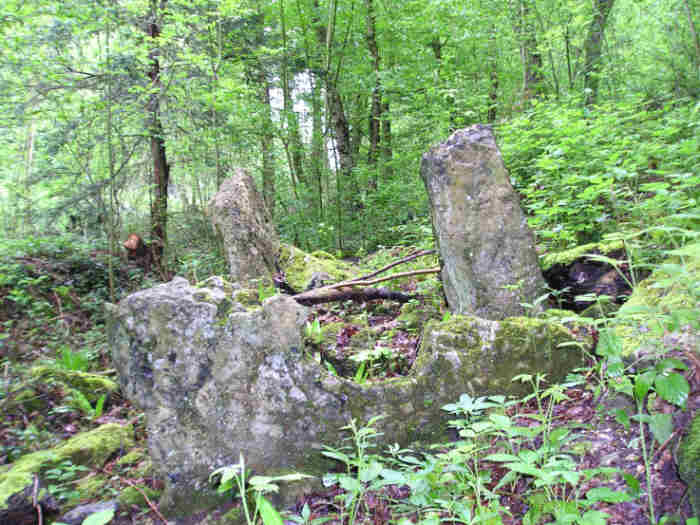
Allée Couverte de Mauny submitted by TheCaptain on 6th May 2005. Mauny Allée Couverte, Eure.
Almost lost in the woods, there is however a very nice half porthole stone which can still be made out.
(View photo, vote or add a comment)
Log Text: A much ruined allée couverte which can be found in woodland beside the D265 road as it climbs the hill from the riverbank below and to the east of Mauny. Almost lost in the woods and currently being used as a junk store it almost looks like its been bulldozed. There is however a very nice half porthole stone which can still be made out. The main chamber is probably about 10 metres long 1.5 metres wide and faces down the valley but most of the remaining stone slabs are just a jumble. Its very much in need of some TLC.
Vielle Cote Dolmen
Trip No.202 Entry No.95 Date Added: 30th Mar 2020
Site Type: Passage Grave
Country: France (Ile-de-France:Val-d'Oise (95))
Visited: Yes on 4th May 2005. My rating: Condition 2 Ambience 3 Access 3
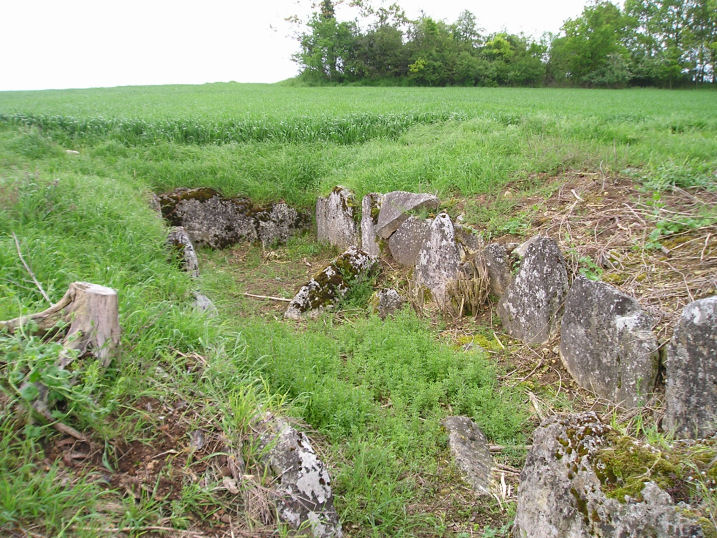
Vielle Cote Dolmen submitted by thecaptain on 23rd Oct 2005. Vielle Cote Dolmen
A much ruined trench grave about 10 metres in length.
(View photo, vote or add a comment)
Log Text: A much ruined trench grave about 10 metres long and 2 metres wide with an orientation of 292° looking down the hill can be found dug into the hillside in a field of crops along a lane at the top of a ridge about 400 metres south from the little lane which climbs eastwards from the village. Although marked on my ign map there are no signs or any other items to suggest its presence. Parking is available at the junction of the lane and track.
Allée Couverte de Dampsmesnil
Trip No.202 Entry No.94 Date Added: 30th Mar 2020
Site Type: Passage Grave
Country: France (Normandie:Eure (27))
Visited: Yes on 4th May 2005. My rating: Condition 4 Ambience 4 Access 3

Allée Couverte de Dampsmesnil submitted by TheCaptain on 6th May 2005. A picture of the female figure stone carving at the entrance to Dampsmesnil Allée Couverte, Eure, France.
Difficult to make out in the picture, but the necklaces and breasts are clear enough.
(View photo, vote or add a comment)
Log Text: It’s easy enough to find the pathway that leads into the woods to this its signed allée couverte from several places from several miles around. However the tiny roads with cropped fields make it almost impossible to park anywhere (certainly a camper van) so it was a long walk. From the lane where the signposted track ascends into the woods its about a half kilometre walk following the main trackway up and keeping left. There is another little sign at a junction of woodland tracks where you turn left and about a further 100 metres along is this nice trench grave along with a little notice board which states that its over 4000 years old and gives descriptions of the various features. When you get there it’s a bit of a corker although falling into disrepair and in need of some affection.
The main chamber is about 10 metres long cut 2 metres deep into the hillside on an orientation of 218° looking down into the valley. There are three massive capstones each more than 3 metres long still in place and the remains of 2 more on this 2 metre wide Allée. The walls consist of large upright slabs with drystone walling between them and the whole thing ends with a massive block at the north-eastern end.
What makes this place a bit special are two features not often found elsewhere. The most obvious is the remains of the lower half of the entrance stone positioned across the chamber with it’s finely cut circular porthole entrance. The top half of the stone is missing but there is enough left to see the fine work which went into creating this entrance. It is very circular with a diameter of about 50 cm made using not just a single cut through the thick stone but a sort of double circular stepped and lipped edge.
The other special feature of this grave is found on the stone just outside the main chamber on the left hand side in front of the porthole stone and with half a capstone sat on it. On this stone has been carved the likeness of a lady (or goddess) and her two breasts can clearly be made out (although in some distant time her left one has been largely hammered away) above which are the remains of four arcs representing necklaces. I thought I could also make out some of her outline and a representation of a belt or other such item. Much of this stone is very worn and indeed I guess its only survived at all due to the presence of the half capstone and I think it said on the notice board that her face could be made out in the past. I wonder who it was.
A few other stones lie scattered about including what was probably one of the capstones which has been removed and lies partway down a steep slope several yards in front of the grave behind the notice board.
After visiting this monument I saw another one marked nearby on the map so set off to look for that. Unfortunately there was a little old narrow bridge between the two places and although my van fitted on to the bridge easily enough I had a lot of trouble getting off the other side and there was no way I was going to be able to reverse back off. After about 6 or 7 attempts to get between the protective bollards in the roadside presumably put there to protect the much wider bridge with a few scrapes down the side of my van and a broken sidelight I had discovered that the gap between the bollards was only an inch wider than the width of my van. I was obviously getting too confident about driving it around all these narrow places and will have to take more care in future.
Menhir dit Gravier de Gargantua (Chateau-Neuf)
Trip No.202 Entry No.93 Date Added: 30th Mar 2020
Site Type: Standing Stone (Menhir)
Country: France (Normandie:Eure (27))
Visited: Yes on 4th May 2005

Menhir dit Gravier de Gargantua (Chateau-Neuf) submitted by thecaptain on 23rd Oct 2005. The Gravier de Gargantua is a big (3.5 metre tall, 2.5 m wide, 0.5 m thick) flinty chalky lump standing beside the road, near the village of Port-Mort in Eure
(View photo, vote or add a comment)
Log Text: A big (3.5 metre tall 2.5 m wide 0.5 m thick) flinty chalky lump stood right beside the roadside in a little fenced enclosure. It was moved here when the road was widened and a metre or so was broken off the top while doing so.
St-Etienne-du-Vouvray burial chamber
Trip No.202 Entry No.92 Date Added: 30th Mar 2020
Site Type: Burial Chamber or Dolmen
Country: France (Normandie:Eure (27))
Visited: Yes on 4th May 2005. My rating: Condition -1
St-Etienne-du-Vouvray burial chamber submitted by theCaptain on 14th Jan 2011. any remains of this once fine trench grave, similar to Dampsnesnil, are now underneath the railway line.
(View photo, vote or add a comment)
Log Text: There are no remains of this gallery grave as it is destroyed and underneath the railway line. It was once a fine trench grave like Dampsnesnil and had many finds.
Saint-Etienne-du-Vauvray Menhir
Trip No.202 Entry No.91 Date Added: 30th Mar 2020
Site Type: Standing Stone (Menhir)
Country: France (Normandie:Eure (27))
Visited: Yes on 4th May 2005. My rating: Condition 3 Ambience 3 Access 5
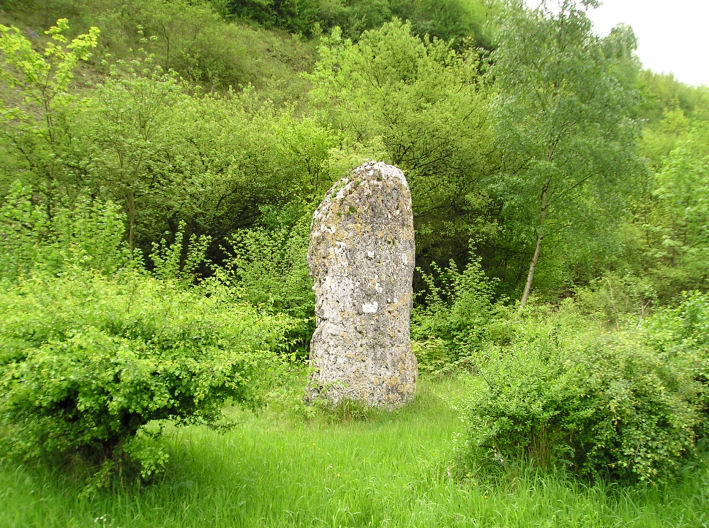
Saint-Etienne-du-Vauvray menhir submitted by thecaptain on 23rd Oct 2005. Saint-Etienne-du-Vauvray menhir, 3.5 metrws tall.
(View photo, vote or add a comment)
Log Text: About a 3.5 metre tall menhir found right beside the roadside between St Etienne and Louviers. Once the road is found the menhir is easy ! The menhir has been moved from its original position which was where the railway now is on the other side of the road.
Dolmen de la Ferme Brûlée
Trip No.202 Entry No.82 Date Added: 30th Mar 2020
Site Type: Burial Chamber or Dolmen
Country: France (Centre:Eure-et-Loire (28))
Visited: Yes on 3rd May 2005

Dolmen de la Ferme Brûlée submitted by thecaptain on 10th Nov 2005. La Ferme Brûlée dolmen.
Just to the south of Fort Harrouard neolithic settlement, on the banks of the river Eure, is another of these dolmens inside a private garden with lots of keep out signs and security fences. However, it can be seen over the gate, down at the end of the driveway.
(View photo, vote or add a comment)
Log Text: Down by the banks of the river Eure are marked on my map a dolmen and polissoir. I couldn’t park close so parked and walked back from some distance away during which time I got soaked by a torrential downpour. I eventually found a house called Le Dolmen but with lots of keep out signs and security devices. Down the far end of the driveway I could see the dolmen and managed a long distance photo of it part hidden by a van. There was no way I could get any sight of the polissoir which was a shame.
La Pierre Courcoulée (Ventes)
Trip No.202 Entry No.79 Date Added: 30th Mar 2020
Site Type: Burial Chamber or Dolmen
Country: France (Normandie:Eure (27))
Visited: Yes on 3rd May 2005. My rating: Condition 3 Ambience 4 Access 4
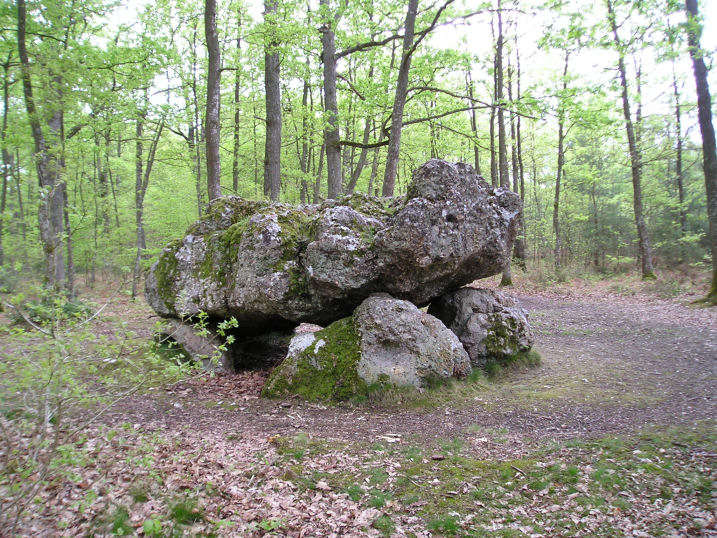
La Pierre Courcoulée (Ventes) submitted by thecaptain on 19th Oct 2005. La Pierre Courcoulée, which can be found in the forest near to the village of Les Ventes, in Eure.
(View photo, vote or add a comment)
Log Text: This dolmen consists of a giant flinty puddingstone capstone sitting on 4 support stones with a couple more fallen inside. The capstone is about 4 metres by 2.5 metres and well over a metre thick.
It is marked on my ign map but there are no signposts at all on the face of the world. Park where the road from the village of Ventes meets the D60 at Le Haut Bois – there’s plenty of space just to the west of the road at a big entrance area to the forest. Do not walk straight into the forest but take the track to the left (southeast) behind the houses. I just followed this track for about half a mile following my nose at each of the junctions and found the dolmen easily enough. Perhaps some unknown power was guiding me after all my recent failures. After my visit just after I got back into my campervan the heavens opened up and there was a massive thunderstorm. Somebody is on my side today.
La Grosse Pierre (Verneusses)
Trip No.202 Entry No.76 Date Added: 29th Mar 2020
Site Type: Burial Chamber or Dolmen
Country: France (Normandie:Eure (27))
Visited: Yes on 2nd May 2005. My rating: Condition 4 Ambience 4 Access 5
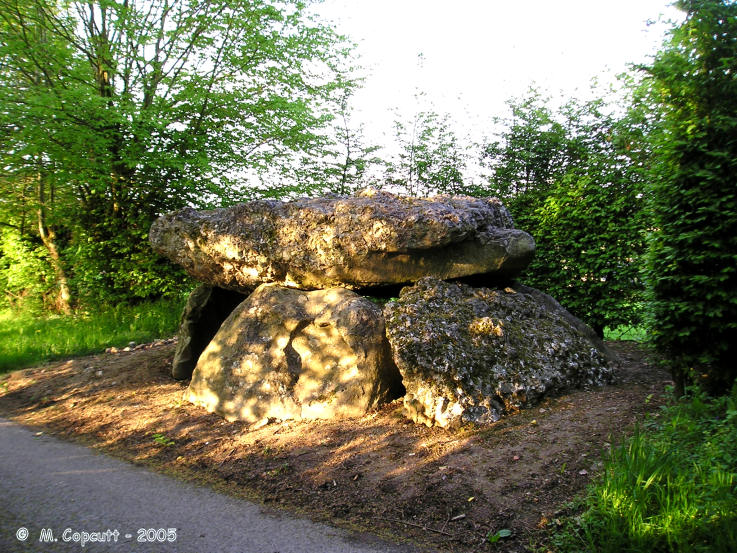
La Grosse Pierre (Verneusses) submitted by thecaptain on 11th Nov 2005. La Grosse Pierre (Verneusses). A nice dolmen largely made from the most wonderful puddingstone slabs.
(View photo, vote or add a comment)
Log Text: A nice simple dolmen right beside the lane just to the east of the hamlet of Verneusses. The large capstone is 4 m by 3.5 m on top of 6 upright support stones. The capstone and one of the upright stones are made from a strange stony conglomerate which has lots of flints in it on one side only. Apparently this dolmen was restored badly nearly two hundred years ago.
Dolmen de la Pierre Couplée
Trip No.202 Entry No.75 Date Added: 29th Mar 2020
Site Type: Burial Chamber or Dolmen
Country: France (Normandie:Orne (61))
Visited: Yes on 2nd May 2005. My rating: Condition 2 Ambience 2 Access 4
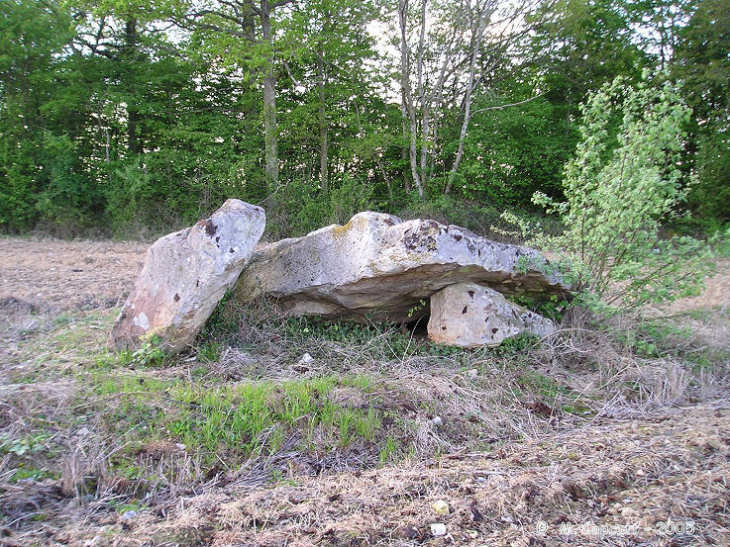
Dolmen de la Pierre Couplée submitted by thecaptain on 11th Nov 2005. La Pierre Couplée, Ferté Frênel, is a poor broken and mistreated dolmen, barely left with enough room to survive in its ploughed field.
(View photo, vote or add a comment)
Log Text: The remains of this dolmen are now within a ploughed field just to the northwest of the village of Ferté Frêsnel on the road to Bocquencé. There is a small signpost to the dolmen but as seems almost always in these parts there is nowhere at all to park.
The dolmen is now very badly looked after ploughed right up to the edges and indeed hit with the machinery in one or two places and covered in muck from muckspreading. The large broken capstone is 4 m by 3 m and there are three collapsed support slabs.
Dolmen de la Forge
Trip No.202 Entry No.77 Date Added: 29th Mar 2020
Site Type: Burial Chamber or Dolmen
Country: France (Normandie:Eure (27))
Visited: Yes on 3rd May 2005
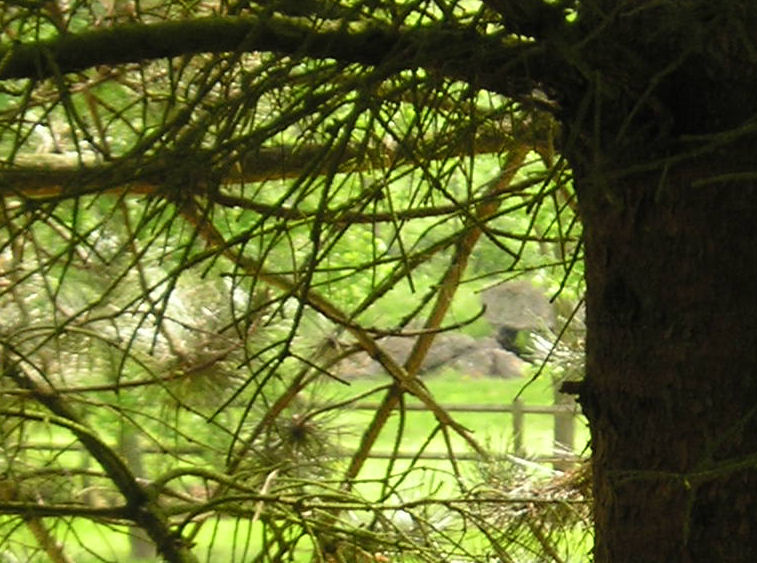
Dolmen de la Forge submitted by thecaptain on 6th Nov 2005. Dolmen de la Forge, Rugles.
This dolmen was a nightmare to find. It took me 3 or 4 attempts to negotiate the one way system in the town before finding the right road alongside the river. Then, after I eventually found somewhere to park and walked back about a kilometre, the dolmen was nigh on impossible to spot.
But it is there in a very private garden with double barbed wire fences, a large hedge and guard dogs.
(View photo, vote or add a comment)
Log Text: Having failed to find this after several attempts yesterday, the next day I checked out the position of this dolmen on the ign 1:25000 map in the supermarket and it looked simple to find so thought I’d have another go. Its north of the town on the little road that runs on the west side of the Risle river. Just past the hamlet of La Forge it should be between the very small road and the river.
After I eventually found somewhere to park and walked back about a kilometre the dolmen is nigh on impossible to spot. But there it is in a very private garden with double barbed wire fences a large hedge and guard dogs the dolmen can be spotted through the trees about 70 metres away from the road.
Getting a picture is a different matter! It looks a bit like the one at Verneusses with a large capstone on several supports.
Dolmen du Jarrier
Trip No.202 Entry No.72 Date Added: 29th Mar 2020
Site Type: Burial Chamber or Dolmen
Country: France (Normandie:Orne (61))
Visited: Yes on 2nd May 2005. My rating: Condition 3 Ambience 2 Access 3
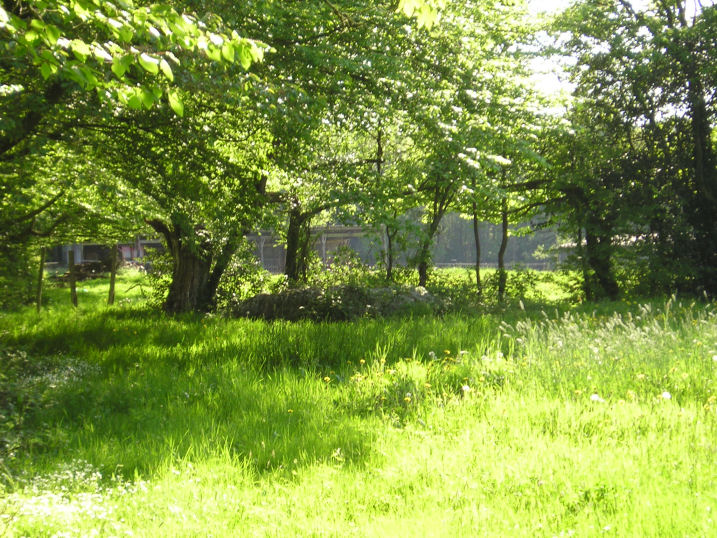
Dolmen du Jarrier submitted by TheCaptain on 10th May 2005. Dolmen du Jarrier, Saint Sulpice-sur-Risle, Orne.
The dolmen can just be seen hiding under the hedge across the field. Typical for this region there is nowhere to park, and of course, no signs to signify its presence.
(View photo, vote or add a comment)
Log Text: A mile or so south of the village centre across both the river and railway on the road to Anglure. The dolmen can be found just before (north of) a crossroads at the top of the hill about 40 metres to the west of the road in a well protected field right under a hedge. It consists of a large capstone resting on four uprights. Typical for this region there is nowhere to park and of course no signs to signify its presence.
Menhir dit de la Chevrolière
Trip No.202 Entry No.71 Date Added: 29th Mar 2020
Site Type: Standing Stone (Menhir)
Country: France (Normandie:Orne (61))
Visited: Yes on 2nd May 2005. My rating: Condition 2 Ambience 2 Access 4
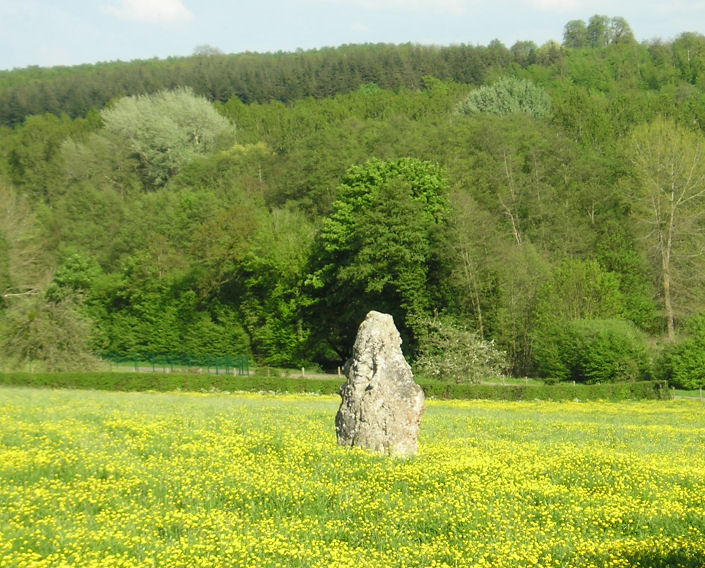
Menhir dit de la Chevrolière submitted by TheCaptain on 10th May 2005. Menhir dit de la Chevrolière, Saint Sulpice-sur-Risle, Orne.
2.8 metre tall menhir, in a field beside the road between Saint Sulpice-sur-Risle village and the town of L’Aigle.
(View photo, vote or add a comment)
Log Text: On the outskirts of the town of L’Aigle can be found this 2.8 metre tall menhir just to the right of the road to Saint Sulpice-sur-Risle village before reaching the new ring road.
Menhirs dits Les Croûtes
Trip No.202 Entry No.68 Date Added: 29th Mar 2020
Site Type: Standing Stones
Country: France (Normandie:Orne (61))
Visited: Yes on 2nd May 2005. My rating: Condition 3 Ambience 3 Access 4
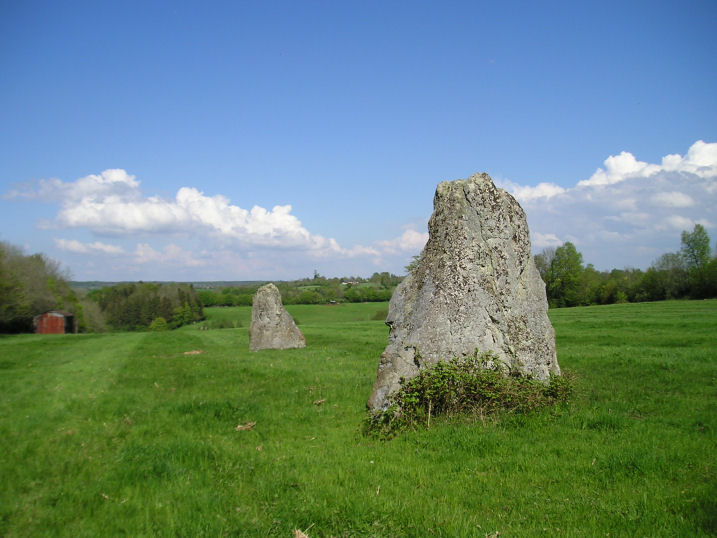
Menhirs dits Les Croûtes submitted by thecaptain on 4th Nov 2005. Les Croûtes are a couple of large (3 metres plus) menhirs stood in a damp field near to the village of Echauffour in Orne.
(View photo, vote or add a comment)
Log Text: A couple of kilometres south of the village of Echauffour can be found a signpost pointing to menhirs along a small track to the east of the road. There is a place to park on this track near the main road and after a couple of hundred metres walk down this track the two menhirs can be seen standing in a field.
Both stones are about 3 metres tall and are spaced about 30 metres apart from each other on an alignment of 055° running down the hill (235° uphill). There is supposed to be a third stone in this alignment and I think I saw it laying under deep undergrowth in the hedge at the top of the field on about an equal spacing although I could not be 100% sure.
La Pierre Levée (Silly)
Trip No.202 Entry No.67 Date Added: 29th Mar 2020
Site Type: Standing Stone (Menhir)
Country: France (Normandie:Orne (61))
Visited: Yes on 2nd May 2005. My rating: Condition 3 Ambience 2 Access 4

La Pierre Levée (Silly) submitted by thecaptain on 3rd Nov 2005. La Pierre Levée (Silly).
I found it difficult to park nearby, so just stopped for a moment at the side of a fairly busy road to take this picture, which does not do it any justice at all.
(View photo, vote or add a comment)
Log Text: To the southeast of the village of Silly-en-Gouffern and just inside the Forêt-de-Petite-Gouffern can be found this enormous menhir about 40 metres from the roadside. It is more than 6 metres tall and several metres wide with its thickness less than a metre. And the top two metres have been broken off !
When I was here I found nowhere to park a camper van and the stone seemed to be located well within a private area with no direct access.
Dolmen dit Pierre-Levée (Fontaine)
Trip No.202 Entry No.65 Date Added: 29th Mar 2020
Site Type: Burial Chamber or Dolmen
Country: France (Normandie:Orne (61))
Visited: Yes on 2nd May 2005. My rating: Condition 2 Ambience 3 Access 5
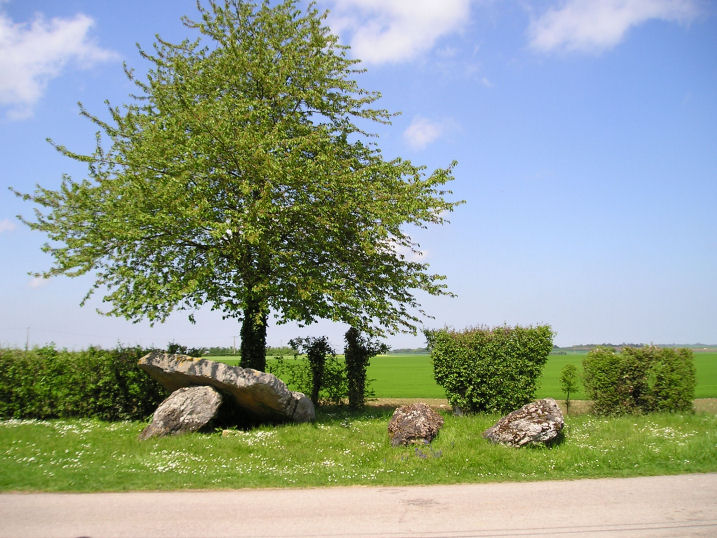
Dolmen dit Pierre-Levée (Fontaine) submitted by thecaptain on 3rd Nov 2005. The much ruined Pierre Levée near to Fontaine-les-Bassets on a fine spring day
(View photo, vote or add a comment)
Log Text: Right beside the road to the west of the village of Fontaine-les-Bassets on the way to Ommoy are the remains of this dolmen. It is hard to make out what exactly the remains consist of. There is one large capstone about 3.5 m by 3 m and about 0.7 m thick leaning up against a solitary remaining support stone on its southeast side. There are a couple of other large slabs laying flat to the ground at the east.
Camp Celtique de Bière
Trip No.202 Entry No.64 Date Added: 29th Mar 2020
Site Type: Ancient Village or Settlement
Country: France (Normandie:Orne (61))
Visited: Yes on 2nd May 2005. My rating: Condition 4 Ambience 5 Access 4
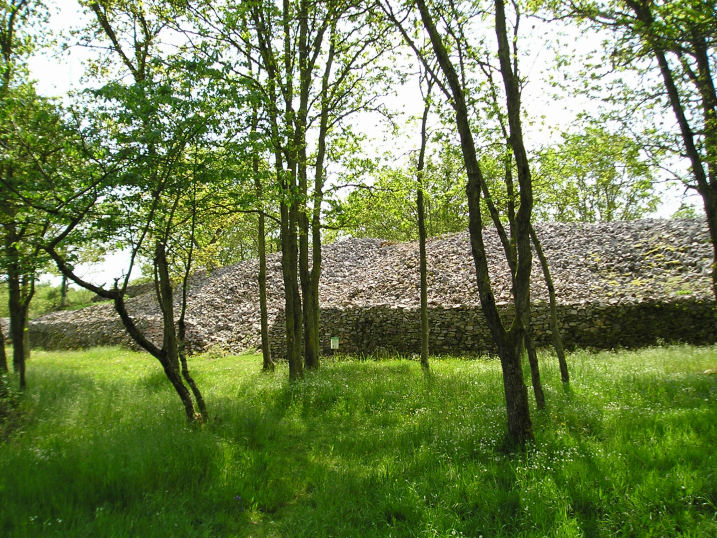
Camp Celtique de Bière submitted by thecaptain on 11th Oct 2005. Camp Celtique de Bière, near the village of Merri Bière in Orne, Normandie
This is a view of the massive southern wall of the northern enclosure, dividing the encampment.
(View photo, vote or add a comment)
Log Text: This is a massive fortified encampment which has been dated back to 4000 BC but with traces of habitation from long before that. The site generally consists of three enclosures on a headland well protected on three sides by steep sided gorges cut by a couple of small streams. The unprotected southern side has three ramparts of various size dates and condition protecting the camp the three ramparts not close together and separating the three enclosures.
It is thought the first encampment was built during the bronze age and was modified at a couple of different times during the Iron Age. The northern rectangular enclosure is the most heavily defended with massive drystone walls thrown up all around particularly at the southern end where the walling is up to 8 metres high. There is the remains of what was once perhaps an entrance through the wall and several of the significant stones used in facing the wall have fossilised trilobites and other marine creatures in them.
It is signposted from nearby and there is a parking area provided a few hundred metres walk to the site. It is now regularly studied and being restored and the enclosed area is now a nature reserve with little signed walks.
Tumulus des Hogues
Trip No.202 Entry No.63 Date Added: 29th Mar 2020
Site Type: Round Barrow(s)
Country: France (Normandie:Orne (61))
Visited: Yes on 2nd May 2005. My rating: Condition 2 Ambience 3 Access 4

Tumulus des Hogues submitted by thecaptain on 1st Nov 2005. Tumulus des Hogues.
The second of the two round burial mounds here, this one has no obvious megalithic chamber to be seen, but its probably still inside.
(View photo, vote or add a comment)
Log Text: There are the remains of two burial mounds here the second one being about 50 metres to the southeast of the Dolmen des Bignes. The mound is much less disturbed than its neighbour but it has been dug into from its western side although there are no signs of any stones forming a chamber. Perhaps its still all in place underneath the mound ? The remains of the mound are about 3 metres high and again it has a diameter of about 15 metres.
The ambience of these burial mounds is spoiled by it obviously used as a place where the local youth (or others) go to have a drink leaving all their detritus behind. There are broken bottles and other rubbish all over the place.
